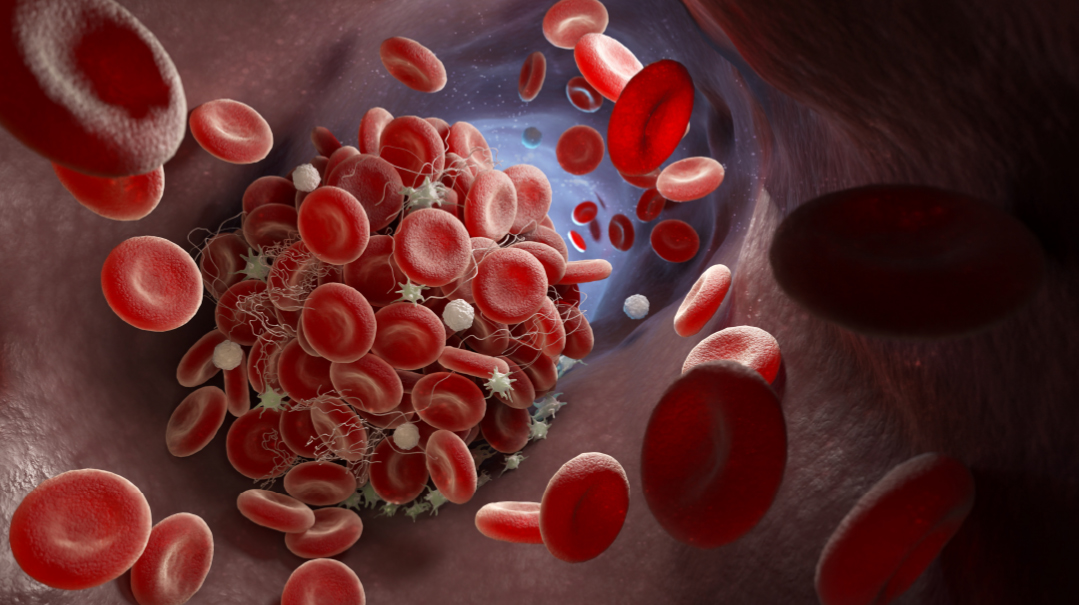When Strange Becomes Scary

It felt like my doctors were playing a diagnosis guessing game

As told to Faigy Peritzman
I’m a busy mom of three, and I work full-time. So when I started feeling unwell in the spring of 2022, I didn’t pay much attention to my symptoms.
Covid was still around, but nobody was testing anymore, and besides, I’d already had Covid, plus I’d been vaccinated, so it was unlikely that it was the virus making me feel so run down. Still, I’d joke that maybe I was experiencing a weird manifestation of Covid.
I was just so tired. Not just the regular “mom who works full-time” tired, but a deep exhaustion — not my usual mode. Still, I was just too busy to pay real attention to myself or do anything about it.
Then I started feeling some odd symptoms. I’d experience recurring episodes of pain in my right eye that would last about five minutes and then go away. After a few days they stopped, and I forgot about it.
Then one day, half of my lip swelled up, and receded only two days later. Again, I thought it was weird but nothing to get worried about. I’d just planted wild onions in my garden, so part of me wondered idly if I’d had some crazy allergic reaction to wild onions.
A few days later, the hairs on my legs started burning. This was seriously strange. It was like every follicle was on fire, making anything that touched my legs, including clothing, so painful. I’d certainly never experienced anything like that before, but I took some pain medication and sure enough a few days later, this pain disappeared, too.
These crazy symptoms were each so random and relatively brief — I didn’t see them as part of a bigger picture, or as cause for concern.
Next, I developed a horrible sore throat. It felt exactly like strep, but I didn’t go to get tested for strep (that was a mistake). Instead, I just used some leftover antibiotics I found at home (another mistake). After another few days, that pain went away, too. All these symptoms occurred over about a month’s time.
ON Memorial Day, my family went away for two days, and during the whole vacation I was taking Ibuprofen and Tylenol around the clock for a terrible headache.
At that point, I figured it was time to see a doctor. When I got home, I made an appointment to see my physician on Wednesday.
He didn’t seem to be too concerned. My bloodwork was all normal, so he told me to eat chicken soup and take vitamin C. He did add that if I wasn’t feeling better by Friday, I should give him a call.
By Thursday, overall, I was feeling better, but then I noticed that something wasn’t quite right with my vision. My vision was slightly out of focus and in my work, I use my eyes a lot.
But I shrugged it off again, figuring I was just tired and worn out. But then I started seeing double. Yes. Double. My close-up vision was fine, but my far-range sight was not.
When I picked up my daughter from school, I saw four men crossing the street, but when I closed one eye, there were only two. The next morning when I drove my kids to school, I drove with only one eye open; it was the only way to control the double vision.
That Friday was Erev Shavuos, and I was super busy cooking and preparing for the three-day Yom Tov. Still, as I was preparing lasagna, I left the doctor a message telling him that I felt better, but was having double vision.
I received the fastest callback ever. Apparently, seeing double is a medical emergency that requires immediate attention, and my doctor told me to go to the emergency room right away.
But I was in the middle of cooking, and I had tons to prepare for Shavuos. I didn’t have the time for a dragged-out ER visit. I figured I’d finish cooking, wait for my husband to return from work, and then I’d go. I called my husband and told him that when he came home, maybe we should go to the emergency room.
My husband was concerned. He told me I should go now and he’d meet me there soon. But I assured him I was feeling fine… I had things in the oven… I didn’t want to drive with only one eye… we could wait a bit….
While I was cooking, I called a cousin who is a nurse practitioner and asked her for a recommendation of which ER to go to. She immediately wanted to know why I was asking, so I told her that the only thing bothering me was my double vision, and it was no big deal, I was waiting for my husband… blah, blah, blah. She realized the potential seriousness of the situation and told me she was coming right then to drive me to the ER.
It was great to have her with me. She was very experienced in the ER and knew when to push, when to listen, and how to advocate for me.
I thought I was going to be there a few hours and then go home, but time was dragging and no one was telling me anything. Finally, they came to tell me that they were actually admitting me to the hospital. “No!” I said. “I can’t — I have lasagna that needs to go into the oven!”
I had way too much to do to be hospitalized. Besides, Shavuos was coming. Who’d watch my kids? And my in-laws were supposed to come for Shavuos!
In the end, my in-laws canceled their plans. My parents were supposed to host people in their home, but they canceled their guests and came to us for Yom Tov. In the meantime, I found a high school girl who could watch the kids until candlelighting, and my husband came to be with me.
The hospital was running a bunch of tests — blood work, spinal tap (so painful! But you gotta do what you gotta do), and a lot of imaging.
They ran CT scans and MRIs of my whole body to rule out a tumor or cancer. The possibility of cancer had never crossed my mind, and suddenly I realized how serious my condition could be.
It was a crazy three days of Yom Tov, and I spent a lot of it alone, as my husband kept going back and forth between the hospital and our home (over an hour’s walk away) trying to be there for me and the kids. Plus, there was an overflow of patients, so while the doctors had wanted to admit me, I was stuck in the chaotic environment of the ER.
Then, to top it all off, the hospital had recently changed over all their computer software, and they couldn’t find many of the images they took because of the new computer programs. The ER was a madhouse, and at one point a nurse was even yelling at a patient, although it certainly wasn’t his fault that the images weren’t there. Several of my MRIs had to be repeated as they were lost, and if you asked anyone for updates, they had no idea where things were holding.
I had a whole team of doctors trying to make sense of my condition, but it didn’t seem like they had any direction. Plus, since it was Yom Tov, I couldn’t even consult with my own doctor or research any of their concerns on my own. I just sat there and waited. It was a scary, lonely time.
Finally, after Yom Tov, they admitted me to the neurology ward, where I was the youngest person there. Most patients had suffered strokes or other neurological conditions.
At this point, the hospital didn’t know what to do with me. Although they had done so much testing, several of the images were still being analyzed, which could take days. The spinal fluid tests can take a really long time. Plus, they’d sent out some blood work for analysis, which could take weeks to process. So in the meantime, they started treating me with high doses of steroids, hoping that maybe that would help.
The MRI did show a lot of lesions in my brain. It was shocking that I’d been able to function with so many lesions. My only symptom at this point was that the muscles in my right eye weren’t working properly, but the way the scans looked, things should’ve been a lot worse.
I was discharged after a week, still without a definitive diagnosis. The doctors suspected that I might have multiple sclerosis (MS), but it felt like a dartboard diagnosis — just throwing an illness at me to see if it would fit.
Upon discharge, the only recommendation I got was to follow up with a physical therapist who specialized in eyes. I called an ophthalmologist who said he didn’t know of any PT specializing in eyes. Then I called a PT who told me there is actually no official eye specialty in physical therapy. So much for that.
Still, I was trying to get appointments with a neurologist and an ophthalmologist. My insurance coverage only extended to New Jersey, but I decided to go out-of-pocket for the top specialists, since even a hospital team of neurologists hadn’t been able to figure out what was wrong with me.
The wait times for top specialist appointments were typically two to three months, but my condition was scary, as I had no answers. I got in touch with an askan who helps people in the frum community seeking medical referrals. He had a lot of connections and helped me decide on which doctor would be best for me. I specifically wanted to see a well-known neurologist that other family members had seen before, but when I contacted his office, they told me there was no way I’d get an appointment soon. Yet because I had family members who were his patients, I was thankfully able to get an appointment with that neurologist within a week.
Based on my previous testing, cancer had been ruled out, but there was a strong suspicion that I was suffering from MS.
I have family members with autoimmune conditions, which tend to strongly run in families. If someone has a certain autoimmune disease, their relatives are more prone to having autoimmune diseases, although not necessarily the same one. Multiple sclerosis is an autoimmune condition that presents with lesions on the brain. So with my family history of autoimmune conditions, MS was a strongly suspected diagnosis.
I went to Mount Sinai Hospital to see this top MS specialist, who conducted a comprehensive two-hour workup and reviewed my medical history. It was he who finally gave me my diagnosis. He didn’t think I had MS, but said I was suffering from acute disseminated encephalomyelitis, otherwise known as ADEM.
I didn’t know what ADEM was at the time, but it turned out to be the best possible outcome. ADEM is very rare. It usually occurs among children younger than ten, and predominantly in males. I’m a woman in my thirties! The cause is unclear, and some say it can be triggered by any virus, or “just out of the blue.” I didn’t remember any virus or sickness that had preceded all my odd symptoms, but eventually the ADEM diagnosis started to add up, especially once I did a repeat MRI. As opposed to MS, ADEM is not a progressive condition. In MS, lesions persist and new ones develop, but when I had my next MRI, my lesions were fading quickly, and at this point it’s like they were never there. My eyes have also fully recovered, baruch Hashem.
Despite the fear and anxiety that accompanied my ordeal, the overall prognosis is heartening. At this point, I only need to have annual follow-up appointments with my neurologist, and he quips that eventually I will “graduate” and not need him at all.
With many other conditions and disorders that could have also aligned with my symptoms, I truly view it as a brachah that this was my diagnosis and not something more chronic or debilitating. I was able to be treated with high doses of IV steroids which worked. I actually recently met someone who had ADEM when she was six years old, and it manifested for her in complete paralysis! It took quite some time and a lot of heartache until she was diagnosed and treated. Even though my experience was quite scary, I’m so grateful that relatively speaking, my symptoms were not as severe and debilitating as hers.
Still, the entire experience was traumatic. Had I spoken to my doctor each time I had a “random” symptom, maybe I could have avoided being stuck in the hospital undergoing a million tests, many of them painful (and expensive).
Had I taken a strep culture when I had strep symptoms and received a negative response, I would have known I needed to consider other causes. When things aren’t “right” there’s a reason. The body is telling us something is up. Sharing my seemingly unrelated symptoms with my doctor would have allowed him to see a bigger picture emerging.
Getting a diagnosis earlier would have made things easier for me. It was so stressful to leave the hospital after so many tests, still not knowing what was wrong. I was left with a lurking fear of a myriad of scary possibilities that had invaded my body.
Ironically, when I finally received my diagnosis, it brought me comfort. I now knew that this was not the beginning a chronic, life-altering deterioration of my body, but a condition that can be treated, and, ideally, as quickly as possible.
I’ve had some big takeaways from my experience. First of all, to realize that abnormal symptoms require attention and should be noted and relayed to medical professionals. It can make the difference in determining the proper diagnosis.
I’ve also learned that double vision is a huge deal and is considered a medical emergency. Who knew?!
On a practical level, I’ve realized that it’s important to maintain a broader coverage of health insurance options. For people living in the Tristate area, but not in New York, it’s worth investing in an insurance plan that allows coverage in NYC. There are a plethora of amazing specialists in NYC who can be outrageously expensive if you don’t have coverage. A single consultation visit is about $1,000. Follow- up visits cost each time also. And while we’d all like to assume we’ll never need such specialists, my story highlighted the fact that our health status can suddenly become precarious.
But perhaps one of the most lasting and heartwarming impressions from my experience is the way my community rallied to help and support our family. We’d moved not long before all this happened, and with Covid and social distancing, I hadn’t made many new friends. Yet throughout my ordeal people were stepping up to drive my kids to and from school, make meals, and just showing overall concern and assistance. It was seriously special.
Our health, and our lives, are always in the Hands of Hashem, and sometimes He needs to send us something scary to remind us of that. I’m just so grateful this experience hasn’t left me with any lasting medical repercussions, though I hope to always remember the lessons I’ve learned.
Did you ever have a medical problem that you were told is “nothing to worry about,” and it ended up being a serious issue? Did you have symptoms that stymied doctors? We believe sharing our journeys can bring awareness, empathy, and a sense of connection to those who’ve gone through a medical crisis. If you had a medical mystery and would like to be part of this column, please send a brief description of your story to familyfirst@mishpacha.com
What Is ADEM?
ADEM, or acute disseminated encephalomyelitis, is a rare neurological condition that causes inflammation in the central nervous system. It often begins about a week or two after a viral or bacterial infection.
The attack damages the myelin sheath around the nerve axon, which is a protective covering that helps transmit information between nerve cells.
ADEM is a sudden acute condition and generally a one-time occurrence.
Signs and symptoms
Since the symptoms of ADEM vary depending on where the inflammation occurs, they can include:
Fever
Headache
Fatigue
Nausea or vomiting
Numbness or tingling in limbs
Difficulty swallowing
Vision loss or difficulty
Muscle weakness
Difficulty walking
Seizures
Treatment for ADEM focuses on reducing inflammation in the brain and spinal cord.
ADEM vs. MS
Since the symptoms and even test results of ADEM may mimic MS, it’s important to distinguish between some key differences.
In most cases, ADEM occurs only once. Patients with MS have further, repeated attacks of inflammation in their brain and spinal cord.
In most cases, there is no new damage in repeated MRI scans for ADEM patients, while MS patients more often find new damage.
Typical symptoms of ADEM, like fever, headache, and confusion, are not usually seen in people with MS.
ADEM occurs more frequently in males, and MS more frequently in females.
ADEM is more common in children, and MS in adults.
Most patients with MS are treated with ongoing medications to prevent attacks. Patients with ADEM generally do not need ongoing medication.
Information from the Clevelandclinic.org
(Originally featured in Family First, Issue 867)
Oops! We could not locate your form.







